Sleep Biohacking: What Works and What Doesn’t
😴 Introduction: The Modern Obsession With Sleep Optimization
From smart rings tracking REM cycles to supplements claiming instant deep sleep, “biohacking” your sleep has become a billion-dollar industry.
We all want to sleep better — but modern life makes that difficult. Blue light, caffeine, stress, and irregular schedules throw off our circadian rhythms, leaving us tired and foggy.
Sleep biohacking promises control — that we can tweak our biology like a system update.
And to some extent, that’s true. You can train your body to rest better.
But not every hack works. Some are backed by neuroscience and physiology. Others are just shiny distractions.
In this guide, we’ll separate the signal from the noise. 🌿
You’ll learn:
What biohacks actually improve sleep quality
Which popular trends waste your time (or money)
The foundational habits that outperform any gadget
Let’s start by understanding how sleep really works.
Looking for supplements for This? Click here.
🧠 Part 1: How Sleep Is Regulated
Sleep is controlled by two main systems:
1️⃣ The Circadian Rhythm — your 24-hour internal clock, governed by light exposure, temperature, and hormones.
2️⃣ The Sleep Pressure System — driven by adenosine, a chemical that builds up while you’re awake and signals fatigue.
When these two systems are aligned, you fall asleep easily and stay asleep.
When they’re disrupted — by blue light, caffeine, or stress — you get insomnia, fragmented sleep, or morning grogginess.
That’s where biohacking comes in: restoring the natural signals your body needs to rest.
🌅 Part 2: Light-Based Biohacks

Light is the strongest environmental cue for your circadian rhythm.
☀️ Morning Sunlight — ✅ Works
This is one of the most effective, free, and science-backed biohacks.
Exposure to natural sunlight within 30 minutes of waking tells your brain it’s daytime, boosting serotonin (for mood and focus) and delaying melatonin release until evening.
How to do it:
Step outside for 10–15 minutes (even on cloudy days)
Avoid sunglasses initially
Combine with movement (walking, stretching) for bonus effect
💡 This single habit can shift your entire sleep cycle over time.
💻 Blue Light Blocking at Night — ✅ Works (With Limits)
Blue light suppresses melatonin production — the hormone that helps you fall asleep.
Wearing blue light glasses or using apps like f.lux or Night Shift after sunset helps, especially if you use screens in the evening.
However, it’s not a full fix. The content you consume (emails, social media, stress triggers) can also spike cortisol.
Verdict: Useful, but only when combined with digital discipline.
💡 Red Light and Dim Lighting — ✅ Works
Switching to warmer, red-spectrum light in the evening mimics sunset and signals your brain to wind down.
It helps your pineal gland produce melatonin naturally.
Use lamps, salt lights, or red bulbs instead of bright overhead LEDs.
🌕 Sleeping With Light Exposure — ❌ Doesn’t Work
Even dim light can reduce melatonin and fragment sleep.
Studies show that as little as 8 lux (a dim lamp) can disrupt deep sleep phases.
Fix: Blackout curtains or an eye mask — essential tools in real sleep optimization.
🌬️ Part 3: Temperature and Sleep Biohacks
Body temperature drops by about 1°C (1.8°F) during sleep. You can accelerate that process for faster onset.
🛁 Hot Shower Before Bed — ✅ Works
A warm bath or shower 1–2 hours before bed increases surface blood flow. When you step out, your body releases heat — triggering sleepiness.
Bonus: Reduces muscle tension and anxiety.
🧊 Cold Exposure — ⚠️ Works, But Timing Matters
Cold plunges or ice showers boost alertness by raising norepinephrine.
That’s great in the morning — terrible before bed.
If you enjoy contrast therapy, end with warmth in the evening.
🌡️ Sleep Environment Cooling — ✅ Works
Your bedroom should be cool — around 18–20°C (65–68°F).
Too hot and your body can’t release heat effectively; too cold and you’ll shiver awake.
Cooling mattresses or breathable bedding are worth the investment.
🌿 Part 4: Nutrition and Supplement Biohacks
Sleep is a metabolic process, not just a mental one. What you eat and supplement with can make or break your rest.
🥗 Avoid Heavy or Sugary Meals Late — ✅ Works
Digesting late-night food keeps your metabolism active, delaying deep sleep.
High-sugar meals also cause blood sugar crashes, leading to 2–3 a.m. awakenings.
Stick to balanced dinners with protein, complex carbs, and healthy fats.
☕ Caffeine Cutoff — ✅ Works (and Is Crucial)
Caffeine blocks adenosine, your sleep pressure molecule.
Even 1 cup of coffee at 3 p.m. can interfere with sleep quality because caffeine’s half-life is 5–6 hours.
Stop caffeine by 2 p.m. at the latest.
🧂 Magnesium Glycinate — ✅ Works
Magnesium regulates GABA and melatonin, both essential for relaxation.
Improves sleep latency (time to fall asleep)
Reduces stress-related awakenings
Calms restless muscles
Dosage: 200–400 mg before bed.
Best forms: glycinate or threonate.
🍵 L-Theanine — ✅ Works
Found in green tea, this amino acid promotes alpha brain waves, the state between wakefulness and sleep.
Dosage: 200–400 mg 30–60 minutes before bed.
Pairs beautifully with magnesium.
💤 Melatonin — ⚠️ Works, But Use Carefully
Melatonin is a hormone, not a supplement.
It’s helpful for:
Jet lag 🌍
Shift work
Delayed sleep phase
But chronic use or high doses (over 1 mg) can desensitize your receptors and disrupt your rhythm.
Best dose: 0.3–1 mg, short-term only.
🌿 Ashwagandha — ✅ Works for Anxiety-Based Insomnia
An adaptogen that lowers cortisol, balances hormones, and improves sleep onset.
Dosage: 300–600 mg extract (Sensoril® or KSM-66®).
🍒 Tart Cherry — ✅ Works
Natural source of melatonin and tryptophan.
Improves sleep duration and muscle recovery.
Dosage: 480 mg extract or 8 oz juice.
💊 Overhyped “Sleep Blends” — ❌ Often Don’t Work
Many commercial sleep supplements combine 10+ ingredients with no clinical synergy.
Focus on 1–3 proven compounds (like magnesium, L-theanine, and glycine).
More ingredients ≠ more results.
Looking for supplements for This? Click here.
🧘 Part 5: Mind-Based and Nervous System Biohacks
Your nervous system is the bridge between stress and sleep. Let’s explore what truly works to calm it.
🧘 Meditation — ✅ Works (Clinically Proven)
Meditation reduces amygdala activity (fear center) and increases GABA production.
Just 10 minutes of mindfulness before bed can lower nighttime cortisol and improve sleep efficiency.
Apps: Headspace, Calm, Insight Timer.
🌬️ Breathwork — ✅ Works
Slow, diaphragmatic breathing activates the vagus nerve, lowering heart rate and blood pressure.
Try:
4-7-8 method
Box breathing (4-4-4-4)
Coherent breathing (5.5-second inhale, 5.5-second exhale)
Want to try Breathwork? Click Here.
💭 Cognitive Behavioral Techniques — ✅ Works
For those with insomnia tied to anxiety, CBT-I (Cognitive Behavioral Therapy for Insomnia) is the gold standard.
It helps reframe thoughts like “I’ll never fall asleep” into more realistic ones like “My body knows how to rest.”
🎧 Binaural Beats — ⚠️ Mixed Results
Low-frequency binaural beats (delta or theta) may enhance relaxation in some people, but results are inconsistent.
If it feels calming, use it. If not, skip it.
🧴 Aromatherapy — ✅ Works for Light Relaxation
Lavender, chamomile, and sandalwood oils reduce heart rate and anxiety.
Diffuse them or spray a light mist on your pillow.
🧘 Weighted Blankets — ✅ Works (for Some)
Deep-pressure stimulation from weighted blankets increases serotonin and oxytocin, mimicking a sense of being held.
Particularly effective for people with anxiety, ADHD, or sensory sensitivity.
Looking for online therapy ? Click Here.
🛌 Part 6: Tech and Tracking — The Good, the Bad, and the Overrated
Biohackers love gadgets. But not every data point helps.
📱 Sleep Trackers — ⚠️ Helpful but Not Perfect
Oura, WHOOP, Apple Watch — they estimate sleep stages using movement and heart rate, not EEG.
What they’re good for: spotting trends (like caffeine impact or bedtime consistency).
What they’re bad for: diagnosing sleep disorders or giving exact REM data.
Tip: Use as a feedback tool, not a scorecard.
🔦 Red Light Therapy — ✅ Promising
Red and near-infrared wavelengths support mitochondrial function and may improve circadian regulation and melatonin.
Use morning or evening for 10–20 minutes.
🎧 Sound Machines and White Noise — ✅ Works
Masking environmental sounds reduces awakenings and improves sleep continuity.
Especially helpful in cities or shared spaces.
📳 Smart Beds, Temperature Pads, and “Sleep Tech” — ⚠️ Situational
Cooling systems (like ChiliSleep or Eight Sleep) help people who overheat.
But most “smart beds” overpromise and underdeliver on sleep enhancement.
Focus on comfort and temperature before expensive gadgets.
🧬 Nootropics and Sleep Biohacks — ❌ Doesn’t Work for Most
Cognitive enhancers (like racetams or modafinil) disrupt natural sleep architecture.
Even if they increase “alertness control,” they usually lead to sleep debt later.
Sleep quality > productivity illusion.
🌈 Part 7: Evening Routine That Combines What Works
Here’s a balanced, evidence-based sleep biohacking routine:
| Time | Action | Purpose |
|---|---|---|
| 7:00 p.m. | Light dinner (protein + complex carbs) | Stabilize blood sugar |
| 8:00 p.m. | Turn off bright screens, dim red lighting | Support melatonin |
| 8:30 p.m. | Magnesium + L-theanine | Calm nervous system |
| 9:00 p.m. | Warm shower | Drop core temperature |
| 9:15 p.m. | Gentle stretching or journaling | Release tension |
| 9:45 p.m. | Breathing or meditation | Activate parasympathetic mode |
| 10:00 p.m. | Sleep | Begin consistent rhythm |
This stack aligns biology, environment, and psychology — no expensive tech required.
🧩 Part 8: Common Biohacking Mistakes to Avoid

🚫 Over-supplementing — Taking too many compounds confuses your nervous system.
🚫 Obsessing over data — Stressing about your sleep score worsens anxiety.
🚫 Ignoring basics — No gadget can fix caffeine overuse or inconsistent schedules.
🚫 Expecting quick fixes — Sleep optimization is a long-term adaptation, not a hack.
🌠 Part 9: Foundational Principles of Real Sleep Biohacking
The most effective “hacks” aren’t futuristic — they’re primal.
✅ Light: Sun in the morning, darkness at night.
✅ Temperature: Cool body, cool room.
✅ Nutrients: Magnesium, glycine, and Omega-3s.
✅ Movement: Regular exercise, but not too late.
✅ Mind: Calm through breath, presence, and routine.
When these pillars align, the body does the rest.
🌙 Final Thoughts: From Hacking to Harmony
Sleep biohacking isn’t about controlling nature — it’s about working with it.
Technology and supplements can help, but the deepest sleep comes from consistency, calm, and circadian respect.
Your body already knows how to rest.
The goal isn’t to force it — it’s to create the conditions for sleep to happen naturally.
So before buying another sleep gadget, try this:
Watch the sunrise.
Dim the lights early.
Breathe deeply.
Trust your biology. 🌿💤
📚 References
Walker, M. Why We Sleep. Scribner, 2017.
Huberman, A. “Science of Sleep and Circadian Rhythms.” Huberman Lab Podcast, 2023.
Peuhkuri, K. et al. “Diet and Sleep: Nutrients and Sleep Regulation.” Nutrients, 2012.
Wienecke, E. et al. “Magnesium Supplementation and Sleep Quality.” J. Res. Med. Sci., 2016.
Kimura, K. et al. “L-Theanine and Relaxation.” Biological Psychology, 2007.
Langade, D. et al. “Ashwagandha Root Extract Improves Sleep Quality.” Cureus, 2020.
Sarris, J. et al. “Nutritional and Herbal Sleep Aids.” Phytotherapy Research, 2020.
Stothard, E. et al. “Light Exposure and Circadian Alignment.” Current Biology, 2017.
Bjorvatn, B. et al. “Temperature and Sleep Onset.” Sleep Medicine Reviews, 2018.
NCCIH. “Relaxation Techniques and Sleep Health.” NIH, 2023.
Related Posts
-

The Connection Between Creativity and Resilience
Creativity and resilience share the same roots — adaptability, flexibility, and imagination. Learn how creative expression rewires your brain for strength, helping you transform stress into growth through neuroscience, art, and self-reflection. 🌿
-

Why Cycling Supplements May Improve Long-Term Resilience
Your body adapts to everything — even supplements. Discover why cycling your supplements helps prevent tolerance, boost energy naturally, and build lasting resilience by aligning with your body’s biological rhythms. 🌿
-

The Role of Biofeedback in Emotional Strength
Learn how biofeedback bridges mind and body — helping you monitor heart rate, breath, and brain activity to build emotional strength, resilience, and calm under pressure. See how science meets mindfulness for lasting control. 🌿
-

How to Stay Strong During Long-Term Stress
Long-term stress doesn’t just drain your energy — it rewires your biology. Discover science-backed ways to strengthen your body, balance your mind, and build lasting resilience through breathwork, nutrition, mindset shifts, and supplements that restore calm and focus. 💪
-

Resilience Training for Entrepreneurs
Entrepreneurship isn’t just about strategy — it’s about stamina. Discover how resilience training helps founders stay calm, clear-headed, and adaptable under pressure through neuroscience-backed habits, emotional regulation, and smart supplementation. 🌿
-

How Nootropics Can Boost Emotional Control
Emotions don’t have to control you. Discover how nootropics like L-theanine, ashwagandha, saffron, and omega-3s help balance brain chemistry, improve focus, and strengthen your ability to stay calm and composed under stress. 🌿
-

Stacking Adaptogens for Maximum Resilience
Adaptogens are nature’s stress shield — helping you stay calm, energized, and clear even under pressure. Learn how to stack herbs like ashwagandha, rhodiola, reishi, and schisandra for maximum resilience, balance, and long-term vitality. 🌿
-
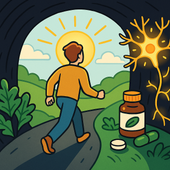
Post-Traumatic Growth and Supplements That Support It
After trauma, true healing means more than survival — it’s transformation. Learn how post-traumatic growth happens in the brain and body, and explore natural supplements like magnesium, ashwagandha, saffron, and omega-3s that support resilience, clarity, and emotional repair.
-
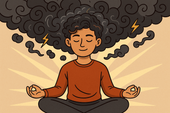
How to Regain Focus After Emotional Stress
After emotional stress, your nervous system feels frayed — your focus fades, thoughts race, and calm seems impossible. Learn how to restore balance, rebuild concentration, and retrain your brain for clarity and peace through evidence-based mind–body tools. 🌿
-
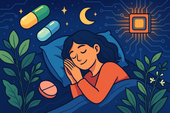
The Future of Sleep Supplements
The future of sleep supplements is here — where science meets nature. Discover how next-generation formulas use adaptogens, amino acids, and biotech innovations to support deep, restorative sleep without dependency. 🌙
-
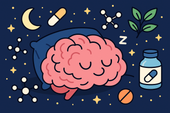
Emerging Research on Sleep and Nootropics
Can nootropics help you sleep better? Discover how compounds like L-theanine, magnesium threonate, ashwagandha, and Alpha-GPC influence neurotransmitters, circadian rhythm, and brain recovery — bridging the gap between smarter days and deeper nights. 🌙
-
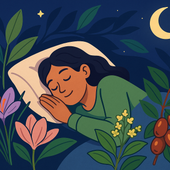
New Herbal Extracts for Deep Sleep
Discover the next generation of herbal extracts for deep sleep — from saffron and magnolia to jujube and lemon balm. Learn how these plant-based compounds calm the nervous system, balance cortisol, and promote truly restorative rest. 🌙
-
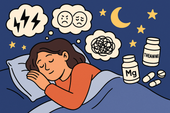
Sleep Support for People with Anxiety Disorders
💭 A restless mind can keep you up all night — thoughts spinning, heart racing, and peace feeling far away. Learn how to quiet overthinking, regulate your nervous system, and create a nightly ritual that teaches your brain to let go and rest deeply. 🌙
-
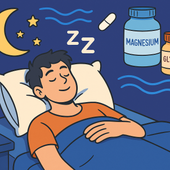
How to Fall Back Asleep After Waking Up
Waking up in the middle of the night? Learn how to fall back asleep quickly and calmly using breathing techniques, stress-reducing rituals, and natural supplements like magnesium and glycine. Restore your body’s rhythm and wake up feeling refreshed.
-
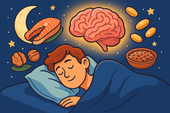
The Role of Omega-3s in Sleep Quality
-
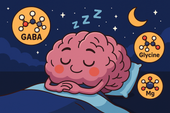
Stacking GABA and Glycine for Deeper Rest
Discover how stacking GABA and glycine can help you achieve deeper, more restorative sleep. Learn how these calming amino acids work together to relax your mind, soothe your body, and improve overall sleep quality—naturally and safely.
-
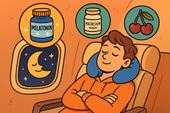
Overcoming Jet Lag with Supplements
✈️ Jet lag doesn’t have to ruin your trip! Discover how supplements like melatonin, magnesium, L-theanine, and tart cherry can help you reset your body clock faster, reduce fatigue, and recover energy naturally after long flights. 🌙
-
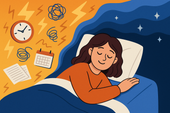
Managing Sleep During Times of Stress
Feeling wired and restless? Learn how to manage sleep during stressful times through nutrition, breathwork, and natural supplements like magnesium and L-theanine. Discover how to calm your nervous system and restore deep, peaceful rest—even when life feels overwhelming.
-
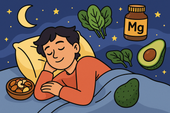
The Role of Magnesium for Night Cramps
Night cramps keeping you awake? Discover how magnesium helps relax muscles, balance electrolytes, and prevent painful spasms. Learn which forms work best, how to take them, and how to pair them with other nutrients for cramp-free, peaceful sleep.
-
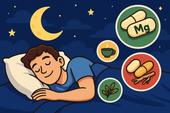
Supplements That Reduce Nighttime Awakenings
🌙 Discover science-backed supplements that help you stay asleep through the night. From magnesium and L-theanine to glycine and ashwagandha, learn how these natural compounds calm your nervous system, balance cortisol, and prevent 2 a.m. wake-ups for deeper, more restorative rest.
-
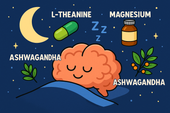
Nootropics That Promote Calm and Rest
Explore the world of calming nootropics — natural brain enhancers that promote relaxation, better focus, and deeper rest. Learn how L-Theanine, magnesium, ashwagandha, and other adaptogens help balance your nervous system, reduce stress, and support restorative sleep.
-
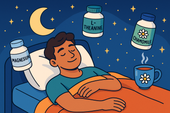
Best Natural Supplement Stack for Sleep
Discover the best natural supplement stack for deep, restorative sleep. Learn how nutrients like magnesium, L-theanine, glycine, and calming herbs such as chamomile and ashwagandha work together to relax your body, calm your mind, and improve sleep quality—naturally and safely.
-
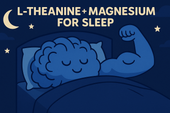
Combining L-Theanine and Magnesium for Sleep: A Calm Night, Naturally
Discover how combining L-Theanine and Magnesium can help you drift into deep, restorative sleep. Learn how this natural duo calms the mind, relaxes the body, and supports your nervous system—without grogginess the next morning.
-
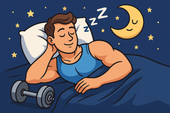
How to Sleep Better After Intense Workouts
Struggling to fall asleep after a tough workout? Learn how to optimize your post-training recovery with nutrition, hydration, and science-backed sleep strategies. Discover how to calm your nervous system, balance hormones, and wake up fully recharged for your next session.
-
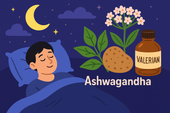
Ashwagandha and Valerian: A Bedtime Combo for Deep Rest and Emotional Reset
Discover the calming synergy of Ashwagandha and Valerian root, two natural sleep aids that help quiet the mind, ease anxiety, and promote deeper rest. Learn how this herbal duo supports the nervous system, balances stress hormones, and restores emotional peace — without next-day grogginess.
-
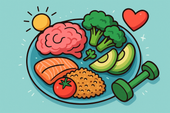
How to Create a Resilience-Boosting Diet
Discover how to build emotional and physical strength from the inside out with a resilience-boosting diet 🍎. Learn which foods stabilize your mood, how supplements like magnesium and omega-3s strengthen your stress response, and why pairing nutrition with breathwork and therapy creates lasting calm, focus, and vitality 🌿💪.
-
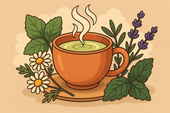
Best Teas and Herbal Blends for Calmness: Nature’s Way to Restore Inner Peace
Ashwagandha, the ancient adaptogenic herb, helps your body find balance during stress. Known as “Indian ginseng,” it supports cortisol regulation, boosts energy, and restores calm clarity. Discover how this powerful root promotes resilience, emotional balance, and steady vitality — one cup at a time. 🌸
-

Parenting and Emotional Strength: How to Raise Children Without Losing Yourself
Empathy is the bridge that connects hearts — the quiet power to understand, feel, and support another’s emotions without judgment. Learn how empathy strengthens relationships, enhances communication, and cultivates deeper compassion in everyday life. 🌿
-
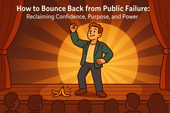
How to Bounce Back from Public Failure: Reclaiming Confidence, Purpose, and Power
Visualization is more than imagination — it’s brain training for resilience. By picturing calm, success, or healing, you activate the same neural pathways as real experience. Learn how daily visualization rewires your brain for confidence, emotional balance, and recovery from stress. ✨
-
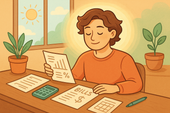
Coping with Financial Stress Through Resilience: How to Stay Grounded When Money Feels Tight
Body awareness is the foundation of emotional resilience. By tuning into your body’s signals — tension, fatigue, or calm — you learn to recognize stress before it overwhelms you. Discover how mindfulness, gentle movement, and breathwork can deepen your connection with your body and restore balance from the inside out. 🧘
-
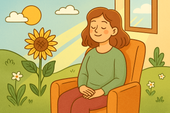
How to Stay Positive During Chronic Illness: A Guide to Emotional Strength and Hope
Creativity is more than art — it’s a form of healing. Whether through painting, writing, music, or small acts of expression, creativity helps release emotion, calm the nervous system, and reconnect you to joy. Discover how to use creativity as a tool for emotional balance, resilience, and self-discovery. 🌿
-
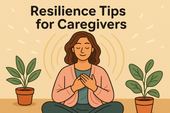
Resilience Tips for Caregivers: How to Stay Strong While Caring for Others
Joy isn’t the absence of pain — it’s the quiet strength to find light even in challenging times. Cultivating joy through small daily moments restores balance, releases stress, and reminds you of life’s beauty. Learn how to reconnect with authentic happiness, rebuild emotional energy, and nurture your nervous system through gratitude, presence, and play. 🌿
-
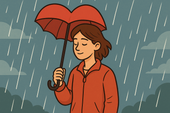
Building Resilience After a Breakup: How to Heal, Rebuild, and Rise Stronger
Social connection is one of the strongest predictors of emotional resilience. During difficult times, genuine relationships act as anchors — calming the nervous system, reducing stress hormones, and helping you regain perspective. Learn how cultivating real human connection can strengthen your mind, heart, and overall well-being. 🌿
-
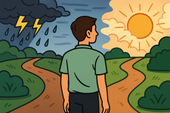
How to Stay Emotionally Strong During Job Loss
Your emotions are powered by brain chemistry — a delicate balance of neurotransmitters like serotonin, dopamine, and cortisol. When these chemicals work in harmony, you feel calm, focused, and resilient. Learn how daily habits, nutrition, and mindfulness can support your brain chemistry and boost emotional well-being naturally. 🌿
-
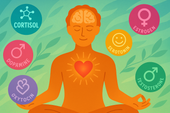
The Role of Hormones in Emotional Stability: How Your Chemistry Shapes Your Calm
Hormones shape more than your body — they shape your emotions, resilience, and sense of calm. From cortisol to serotonin, these chemical messengers influence how you react to stress, connect with others, and recover from challenges. Learn how to balance your hormones naturally to build lasting emotional stability and harmony within. 💫
-
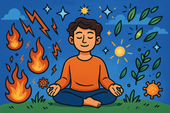
Mitochondria and Emotional Energy: The Cellular Power Behind Your Mood
Breathwork is one of the most powerful tools for emotional regulation and cellular balance. Through intentional breathing, you can calm your nervous system, increase oxygen flow to the brain, and even support mitochondrial energy. Learn how conscious breathing connects body and mind — transforming stress into presence and emotional strength. 🌿
-
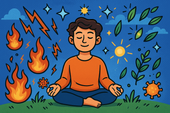
Inflammation and Its Impact on Mood Resilience: The Silent Link Between Body and Mind
Inflammation doesn’t just affect the body — it impacts the mind. Chronic inflammation alters brain chemistry, depletes serotonin, and makes emotional recovery harder. Learn how calming inflammation through nutrition, mindfulness, and sleep can restore balance, resilience, and a renewed sense of emotional strength. 💫
-
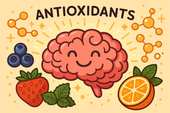
How Antioxidants Protect Emotional Well-being: The Hidden Link Between Oxidative Stress and Mental Health
Antioxidants do more than protect your body — they defend your mind. By neutralizing oxidative stress, antioxidants support serotonin, dopamine, and brain energy pathways that keep you calm, focused, and emotionally balanced. Discover how foods like berries, green tea, and dark chocolate nourish your brain, boost mood, and strengthen resilience from the inside out. 🌿✨
-
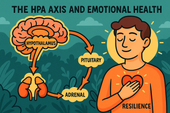
The HPA Axis and Emotional Health: The Hidden Bridge Between Stress and Mind
Neuroplasticity — the brain’s ability to rewire and adapt — is the foundation of emotional healing and resilience. When you face stress, trauma, or change, your neural pathways can reshape themselves to support new patterns of calm, focus, and self-awareness. Learn how daily practices like mindfulness, therapy, and breathwork strengthen neuroplasticity to transform emotional pain into personal growth. 🌸
-
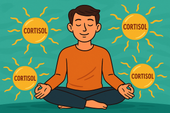
Why Cortisol Control Is Key to Resilience: Mastering Stress to Build Emotional Strength
Controlling cortisol — the body’s main stress hormone — is the secret to lasting resilience. When cortisol levels stay balanced, your mind becomes clearer, emotions steadier, and energy more sustainable. Learn how breathwork, mindset shifts, adaptogens, and daily rhythms can help you calm your stress response and build true inner strength. 🌞💪
-
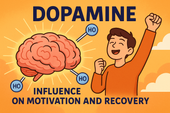
Dopamine’s Influence on Motivation and Recovery: Reigniting Drive and Balance
Healthy relationships are the foundation of emotional balance and resilience. Whether romantic, familial, or platonic, genuine connection releases dopamine, serotonin, and oxytocin — the brain’s “bonding trio” — helping us feel secure, motivated, and seen. Learn how trust, empathy, and communication not only strengthen your connections but also reshape your nervous system for deeper emotional well-being. 🌿🤝
-
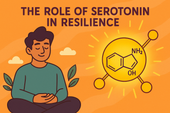
The Role of Serotonin in Resilience: How This “Mood Molecule” Shapes Emotional Strength
Serotonin — often called the “resilience molecule” — plays a vital role in how we handle stress, regulate mood, and recover from emotional challenges. Beyond happiness, this powerful neurotransmitter helps balance the gut-brain axis, stabilize the nervous system, and support emotional flexibility. Learn how nutrition, sunlight, mindfulness, and adaptogens can naturally boost serotonin and strengthen your emotional resilience. 🌞🧠
-
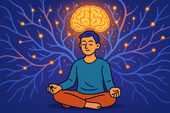
How Neuroplasticity Supports Emotional Growth: Rewiring the Brain for Resilience
Neuroplasticity is the brain’s built-in power to grow, adapt, and heal — and it’s the foundation of emotional transformation. Every mindful breath, compassionate act, or reframed thought strengthens new neural pathways that support resilience and self-awareness. Learn how your brain rewires through daily habits, helping you turn emotional challenges into opportunities for growth and calm. 🌿
-
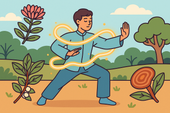
Tai Chi and Adaptogens for Mind-Body Balance: The Art of Harmonizing Energy and Resilience
Alchemy isn’t just an ancient science — it’s a timeless symbol of transformation and inner balance. By blending the physical and spiritual, alchemy teaches us that change begins from within. Just as metals are refined into gold, we too can transmute emotional pain, stress, and chaos into clarity and strength through mindful practice and self-awareness. 🌙✨
-
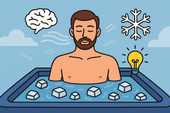
Cold Therapy and Emotional Control: Training the Mind Through the Body
Cold therapy isn’t just for athletes — it’s a tool for emotional mastery. By exposing your body to controlled cold, you train your nervous system to stay calm under stress, improving focus, mood, and resilience. This article explores the science of cold exposure, its impact on hormones and the vagus nerve, and how ice baths and cold showers can help you build emotional control, one breath at a time. 🧊🧘♂️
-
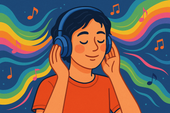
How Music Influences Emotional Recovery: The Healing Soundtrack of the Mind
Neuroplasticity — the brain’s ability to rewire and heal itself — is at the heart of emotional recovery. Through mindful habits, music, therapy, and consistent mental stimulation, your brain can form new connections that support resilience and well-being. Discover how neuroplasticity turns pain into growth, helping you rebuild balance, focus, and emotional strength. 🌿
-
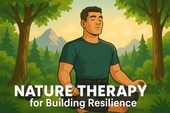
Nature Therapy for Building Resilience: Reconnecting With the Healing Power of the Earth
Nature therapy helps rebuild emotional resilience by reconnecting you with the healing rhythms of the Earth. From forest walks to sunlight exposure, nature restores balance to your nervous system, lowers stress hormones, and teaches emotional adaptability. Learn how spending time outdoors can enhance mental clarity, calm anxiety, and awaken your natural capacity to heal. 🌞
-
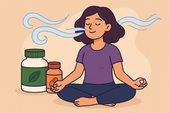
Breathwork Techniques That Pair with Supplements: The Ultimate Synergy for Stress Relief and Mental Clarity
Breathwork and supplements create a powerful mind-body synergy for stress relief, focus, and energy. By combining intentional breathing with adaptogens, nootropics, and calming nutrients, you can naturally regulate cortisol, sharpen mental clarity, and boost emotional balance. This guide explores the best breathwork techniques and supplement pairings to help you feel centered, calm, and energized from the inside out. 🌿
-
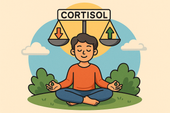
Why Cortisol Balance Matters for Emotional Strength
Balancing cortisol — your body’s main stress hormone — is essential for emotional resilience. When cortisol is chronically high, your mind stays stuck in survival mode, leading to fatigue, anxiety, and emotional instability. This article explores how nutrition, supplements, breathwork, and therapy can help restore healthy cortisol rhythms, regulate the nervous system, and strengthen your ability to handle life’s challenges with calm focus and emotional strength. 🌿

















































